 Dedication To Rhona: For the understanding, for the sacrifices, and for the love Copyright 2016, 2012, 2009, 2005, 2000, and 1996 by Barrons Educational Series, Inc. All rights reserved. No part of this publication may be reproduced or distributed in any form or by any means
Dedication To Rhona: For the understanding, for the sacrifices, and for the love Copyright 2016, 2012, 2009, 2005, 2000, and 1996 by Barrons Educational Series, Inc. All rights reserved. No part of this publication may be reproduced or distributed in any form or by any means
without the written permission of the copyright owner. All inquiries should be addressed to: Barrons Educational Series, Inc. 250 Wireless Boulevard Hauppauge, New York 11788 www.barronseduc.com eISBN: 978-1-4380-6811-4 Publication date: June, 2016  T his new edition of the Barrons SAT Math Workbook is based on the redesigned 2016 SAT. It is organized around a simple, easy-to-follow, and proven four-step study plan: STEP Know what to expect on test day.
T his new edition of the Barrons SAT Math Workbook is based on the redesigned 2016 SAT. It is organized around a simple, easy-to-follow, and proven four-step study plan: STEP Know what to expect on test day.
STEP Become testwise. STEP Review SAT Math topics and SAT-type questions. STEP Take practice exams under test conditions. STEP 1 KNOW WHAT TO EXPECT ON TEST DAY Chapter 1 gets you familiar with the format of the test, types of math questions, and special directions that will appear on the SAT you will take. This information will save you valuable testing time when you take the SAT. It will also help build your confidence and prevent errors that may arise from not understanding the directions on test day.
STEP 2 BECOME TESTWISE By paying attention to the test-taking tips and SAT Math facts that are strategically placed throughout the book, you will improve your speed and accuracy, which will lead to higher test scores. Chapter 2 is a critically important chapter that discusses essential SAT Math strategies while also introducing some of the newer math topics that are tested by the redesigned SAT. STEP 3 REVIEW SAT MATH TOPICS AND SAT-TYPE QUESTIONS The SAT test redesigned for 2016 and beyond places greater emphasis on your knowing the topics that matter most from your college preparatory high school mathematics courses. Chapters 3 to 6 serve as a math refresher of the mathematics you are expected to know and are organized around the four key SAT Math content areas: Heart of Algebra, Problem Solving and Data Analysis, Passport to Advanced Math, and Additional Topics in Math (geometric and trigonometric relationships). These chapters also feature a large number and variety of SAT-type math questions organized by lesson topic. The easy-to-follow topic and lesson organization makes this book ideal for either independent study or use in a formal SAT preparation class.
Answers and worked-out solutions are provided for all practice problems and sample tests. STEP 4 TAKE PRACTICE EXAMS UNDER TEST CONDITIONS Practice makes perfect! At the end of the book, you will find two full-length SAT Math practice tests with answer keys and detailed explanations of answers. Taking these exams under test conditions will help you better manage your time when you take the actual test. It will also help you identify and correct any remaining weak spots in your test preparation. Lawrence S. Leff Welcome to Barrons Math Workbook for the NEW SAT e-Book version! Please note that depending on what device you are using to view this e-Book on, equations, graphs, tables, and other types of illustrations will look differently than it appears in the print book.
Please adjust your device accordingly. This e-Book contains hundreds of hyper links that will bring you to helpful resources and allow you to click between questions and answers.  LEARNING ABOUT
LEARNING ABOUT
SAT MATH  T his chapter introduces you to the test format, question types, and the mathematics topics you need to know for the redesigned 2016 SAT. Compared to prior editions of the SAT, the new SAT Places a greater emphasis on algebra: forming and interpreting linear and exponential models; analyzing scatterplots, and two-way tables. Includes two math test sections: in one section you can use a calculator and in the other section a calculator is not allowed. Does not deduct points for wrong answers.
T his chapter introduces you to the test format, question types, and the mathematics topics you need to know for the redesigned 2016 SAT. Compared to prior editions of the SAT, the new SAT Places a greater emphasis on algebra: forming and interpreting linear and exponential models; analyzing scatterplots, and two-way tables. Includes two math test sections: in one section you can use a calculator and in the other section a calculator is not allowed. Does not deduct points for wrong answers.
LESSONS IN THIS CHAPTER Lesson 1-1Getting Acquainted with the Redesigned SAT Lesson 1-2Multiple-Choice Questions Lesson 1-3Grid-In Questions OVERVIEW The March 2016 SAT test date marks the first administration of a redesigned SAT. The mathematics content of the new version of the test will be more closely aligned to what you studied in your high school math classes. The redesigned SAT is a timed exam lasting 3 hours (or 3 hours and 50 minutes with an optional essay). What Does the SAT Measure? The math sections of the new SAT seek to measure a students understanding of and ability to apply those mathematics concepts and skills that are most closely related to successfully pursuing college study and career training. Why Do Colleges Require the SAT? College admissions officers know that the students who apply to their colleges come from a wide variety of high schools that may have different grading systems, curricula, and academic standards. SAT scores make it possible for colleges to compare the course preparation and the performances of applicants by using a common academic yardstick.
Your SAT score, together with your high school grades and other information you or your high school may be asked to provide, helps college admission officers to predict your chances of success in the college courses you will take. How Have the SAT Math Sections Changed? Here are five key differences between the math sections of the SAT given before 2016 and the SAT for 2016 and beyond: There is no penalty for wrong answers. Multiple-choice questions have four (A to D) rather than five (A to E) answer choices. Calculators are permitted on only one of the two math sections. There is less emphasis on arithmetic reasoning and a greater emphasis on algebraic reasoning with more questions based on real-life scenarios and data. New Math Topics Beginning with the 2016 SAT, these additional math topics will now be required: Manipulating more complicated algebraic expressions including completing the square within a quadratic expression.
For example, the circle equation x 2 + y 2 + 4 x 10 y = 7 can be rewritten in the more convenient center-radius form as ( x + 2)2 + ( y 5)2 = 36 by completing the square for both variables. Performing operations involving the imaginary unit i where i =  . Solving more complex equations including quadratic equations with a leading coefficient greater than 1 as well as nonfactorable quadratic equations. Working with trigonometric functions of general angles measured in radians as well as degrees. Table 1.1 summarizes the major differences between the math sections of the previous and newly redesigned SATs. TIP If you dont know an answer to a n SAT Math question, make an educated guess! There is no point penalty for a wrong answer on the redesigned SAT.
. Solving more complex equations including quadratic equations with a leading coefficient greater than 1 as well as nonfactorable quadratic equations. Working with trigonometric functions of general angles measured in radians as well as degrees. Table 1.1 summarizes the major differences between the math sections of the previous and newly redesigned SATs. TIP If you dont know an answer to a n SAT Math question, make an educated guess! There is no point penalty for a wrong answer on the redesigned SAT.
You get points for the questions you answer correctly but do not lose points for any wrong answers. Table 1.1 Comparing Old and New SAT Math
| Test Feature | Old SAT Math (before 2016) | Redesigned SAT Math (2016 and after) |
| Test Time | 70 minutes | 80 minutes |
| Number of sections | Three | Two: one 55-minute calculator section and one 25-minute no-calculator section |
| Number of questions |
Next page
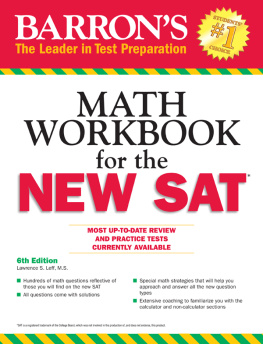


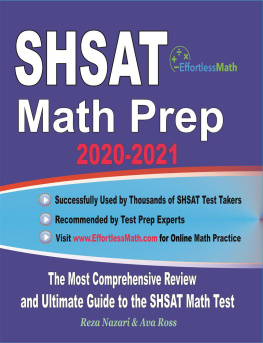
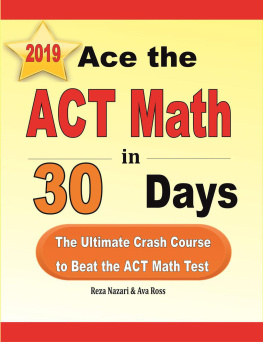
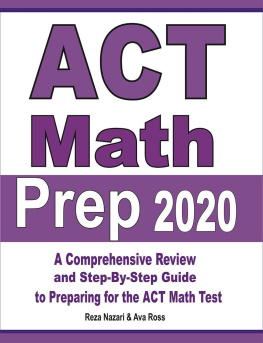
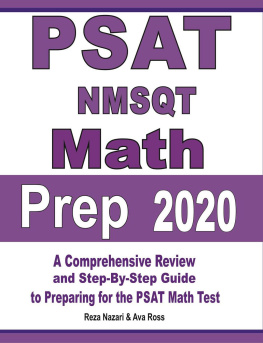
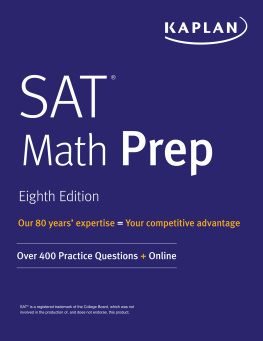
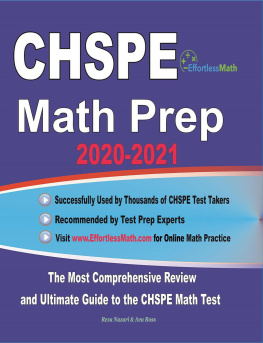
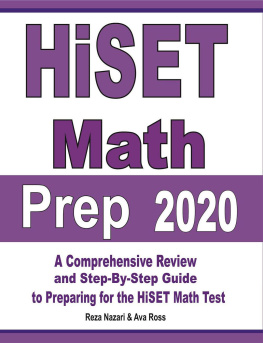
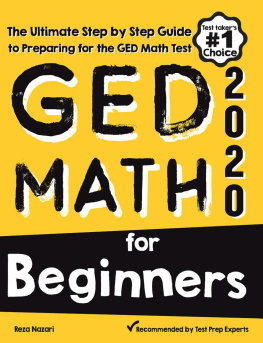
 Dedication To Rhona: For the understanding, for the sacrifices, and for the love Copyright 2016, 2012, 2009, 2005, 2000, and 1996 by Barrons Educational Series, Inc. All rights reserved. No part of this publication may be reproduced or distributed in any form or by any means
Dedication To Rhona: For the understanding, for the sacrifices, and for the love Copyright 2016, 2012, 2009, 2005, 2000, and 1996 by Barrons Educational Series, Inc. All rights reserved. No part of this publication may be reproduced or distributed in any form or by any means T his new edition of the Barrons SAT Math Workbook is based on the redesigned 2016 SAT. It is organized around a simple, easy-to-follow, and proven four-step study plan: STEP Know what to expect on test day.
T his new edition of the Barrons SAT Math Workbook is based on the redesigned 2016 SAT. It is organized around a simple, easy-to-follow, and proven four-step study plan: STEP Know what to expect on test day. . Solving more complex equations including quadratic equations with a leading coefficient greater than 1 as well as nonfactorable quadratic equations. Working with trigonometric functions of general angles measured in radians as well as degrees. Table 1.1 summarizes the major differences between the math sections of the previous and newly redesigned SATs. TIP If you dont know an answer to a n SAT Math question, make an educated guess! There is no point penalty for a wrong answer on the redesigned SAT.
. Solving more complex equations including quadratic equations with a leading coefficient greater than 1 as well as nonfactorable quadratic equations. Working with trigonometric functions of general angles measured in radians as well as degrees. Table 1.1 summarizes the major differences between the math sections of the previous and newly redesigned SATs. TIP If you dont know an answer to a n SAT Math question, make an educated guess! There is no point penalty for a wrong answer on the redesigned SAT.